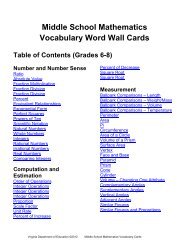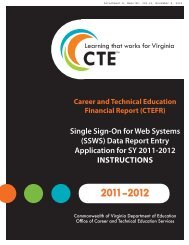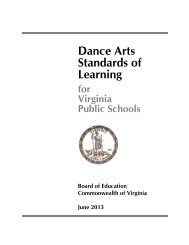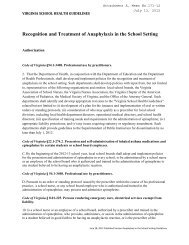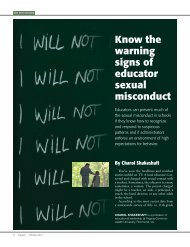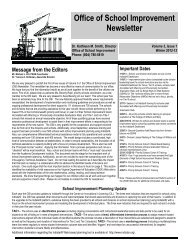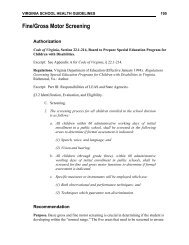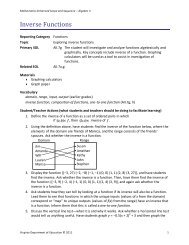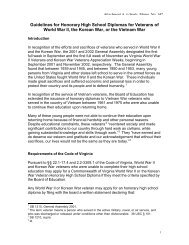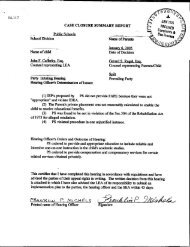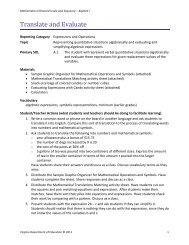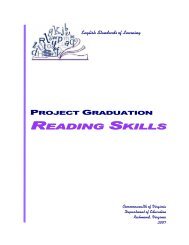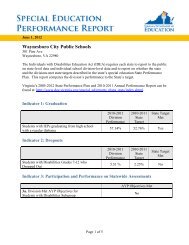What Makes Something Alive - Virginia Department of Education
What Makes Something Alive - Virginia Department of Education
What Makes Something Alive - Virginia Department of Education
You also want an ePaper? Increase the reach of your titles
YUMPU automatically turns print PDFs into web optimized ePapers that Google loves.
Topic 4: Session 4.3 – Frogs<br />
Session Supplies:<br />
• Teacher-selected nonfiction book about the life cycle <strong>of</strong> frogs<br />
• Photographs <strong>of</strong> a variety <strong>of</strong> different frogs<br />
• Computer internet access (if possible)<br />
• Fact pages on the pickerel frog, bullfrog, little grass frog, northern green frog, and<br />
mountain chorus frog (pg. 136-140) (or online at<br />
http://www.dgif.virginia.gov/wildlife/information/?t=1 )<br />
• Sampling <strong>of</strong> <strong>Virginia</strong> Frog Length Data sheet (pg. 141) (There are two data sheets on each<br />
page. Cut the page in half. Each student needs only one data sheet.)<br />
• Sampling <strong>of</strong> <strong>Virginia</strong> Frog Length Data – teacher key (pg. 142)<br />
• Meter stick<br />
• Female Frog Length Recording sheets (pg. 143-144)<br />
• Male Frog Length Recording sheets (pg. 145-146)<br />
Session <strong>Virginia</strong> SOL<br />
Science English Mathematics History & Social Science<br />
2.2 a, b, c, e<br />
2.11 a<br />
2.3 a, b, c, d, e<br />
2.7 e<br />
2.9 a, c, d, e, f<br />
2.10 b, d<br />
2.12 a, c, d<br />
2.14<br />
2.1 a, b, c, d, e, h, i, j, k,<br />
l<br />
2.4 a<br />
Session 4.3 – Frogs<br />
Teacher Questions & Notes<br />
-Do you think all frogs have the same<br />
life cycle?<br />
Procedures<br />
1. Read and discuss the teacher-selected nonfiction book about the<br />
life cycle <strong>of</strong> frogs.<br />
2. Show students photographs <strong>of</strong> a variety <strong>of</strong> frogs. Lead students to<br />
the understanding that different species still go through the same<br />
stages <strong>of</strong> a life cycle.<br />
-<strong>What</strong> do you notice about the frogs?<br />
3. Compare and contrast the photographs <strong>of</strong> the frogs. Guide<br />
students to notice the different sizes <strong>of</strong> the frogs.<br />
4. Tell students that they are going to look at one specific<br />
characteristic <strong>of</strong> frogs for several <strong>Virginia</strong> frog species. They will<br />
research information for each species, record it on a data table,<br />
and analyze what has been discovered.<br />
NOTE: The specific <strong>Virginia</strong> frogs for which students will gather<br />
data are:<br />
a. pickerel frog<br />
b. bullfrog<br />
133<br />
<strong>Virginia</strong> Animals and their Habitats<br />
Topic 4



